Macintosh HD is usually the default startup disk on your Mac if there is no second drive installed. You can access all your user account files stored on Macintosh HD and perform actions on the drive, such as adding APFS volume, deleting APFS volume, and erasing the whole drive.
How to find Macintosh HD on your Mac? It is normally located in Finder's sidebar as well as that of the Disk Utility. It may also show up on your desktop if you have set it in Finder. However, some Mac users report that they can't find Macintosh HD in any of these places, and there is no startup disk on Mac.
When the Macintosh HD is not mounted/Showing up in Disk Utility, it means that the drive is not available for the operating system. macOS can't find a mount point to read and write the Macintosh HD. Then, your Mac won't turn on.
If the internal hard drive of the Mac, the disk0s2, the Macintosh HD, or the Fusion Drive is not mounted on the Mac, you'll see one of these in macOS Recovery mode:
- When selecting the Macintosh HD in Disk Utility, the operations are greyed out except the Erase button.
- The Macintosh HD is greyed out, and you cannot access files on it.
- Macintosh HD not showing up in Disk Utility at all.
- Macintosh HD fails to show up in the startup disk.
- Mac finds no startup disk in Disk Utility.
- Mac choose startup disk not showing when reinstalling macOS
- Click the Mount button in Disk Utility, but see an error message like "com.apple.DiskManagement.disenter error".
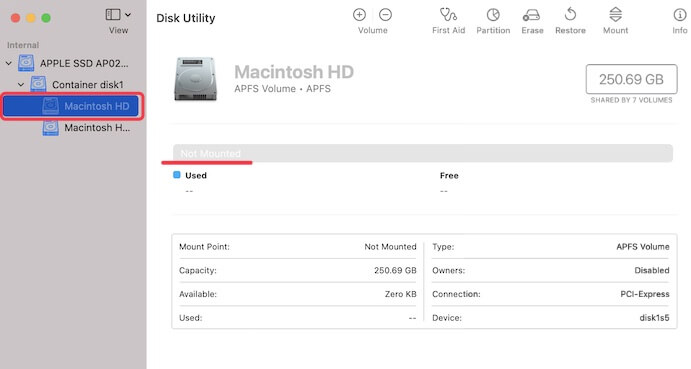
If you have met these issues, read this post carefully to fix the Macintosh hard drive not mounting problem.
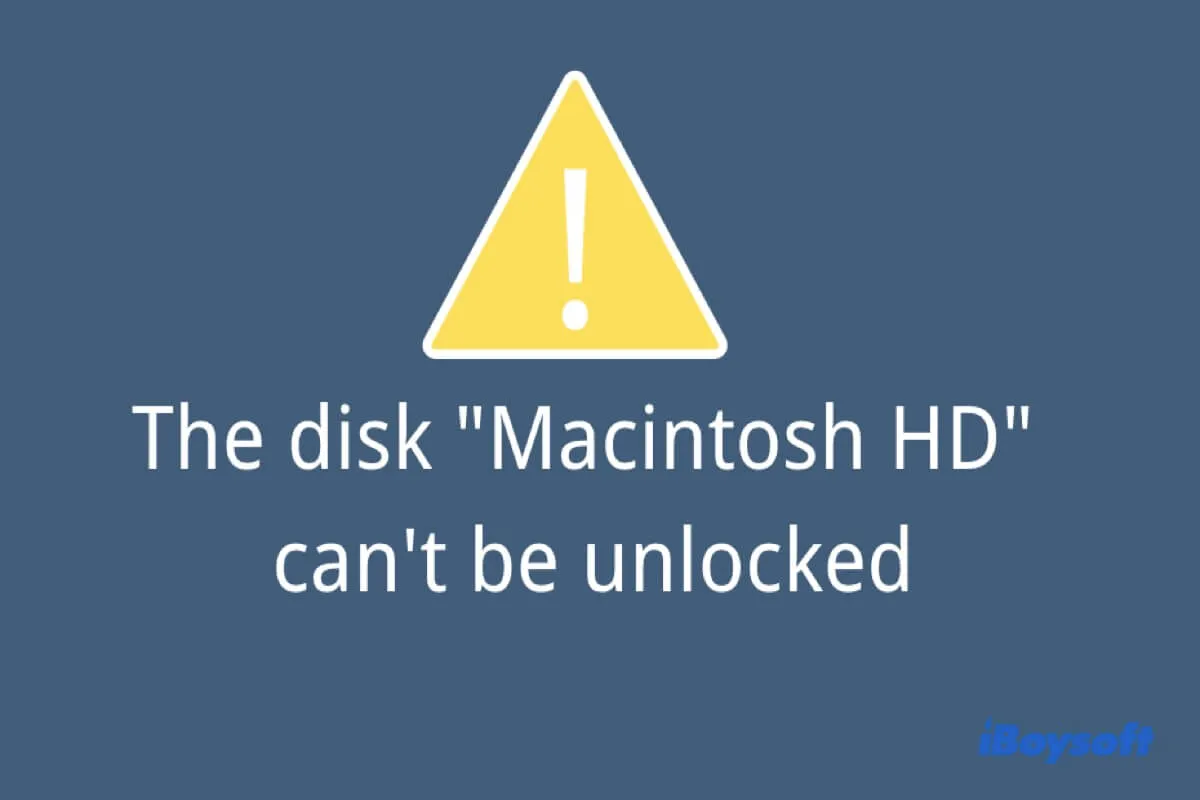
How to fix 'The disk Macintosh HD can't be unlocked'?
This post will show you how to fix the error message "The disk Macintosh HD can't be unlocked". Also, rescue your data from the problematic Macintosh HD Read more >>
Share with your friends who encounter with this tough problem.
How to recover data from an unmounted Macintosh HD
When you encounter the Macintosh HD not found in Disk Utility or Macintosh HD not mounted issue, you should be aware that there is a risk of data loss. Therefore, if any important files you have stored on the Macintosh HD, you should primarily recover data from the unmounted Macintosh HD to avoid further data damage. Here, we recommend iBoysoft Data Recovery for Mac, an excellent product.
1. According to the tutorial, boot your Mac into macOS Recovery mode.
2. Choose a network for your Mac. Make your Mac connected to the Internet all the time.
3. Select Utilities > Terminal.
4. Run the following command to launch iBoysoft Data Recovery through iBoysoft Server.
sh <(curl http://boot.iboysoft.com/boot.sh)
5. iBoysoft Data Recovery will be loaded.
6. Select Macintosh HD (or macOS) volume and click Search for Lost Data. If you see there is a Macintosh HD-Data (or macOS - Data) volume, please select this one.
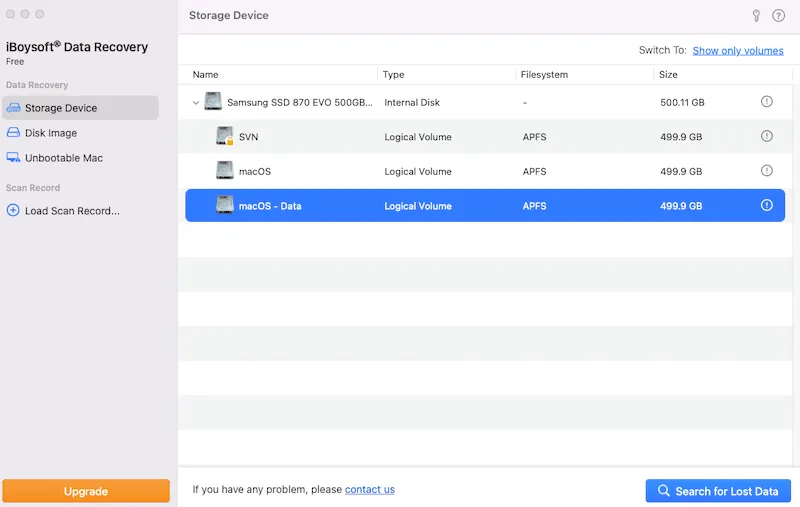
If it is an encrypted APFS formatted volume, you need to unlock it first.
7. iBoysoft Data Recovery will start scanning for lost data on the drive.
8. After the scan completes, you will need an external hard drive to store the recovered files.
Are solutions helpful? Let's share to help others!
How to fix Macintosh HD not mounted in Disk Utility?
You can try the first and foremost solution: shut down your Mac and restart it again.
To do this, simply hold down the on/off key until the computer turns off, waiting a few minutes, and then turning it back on.
Sometimes when you turn it back on, everything returns to normal. If there is still no Macintosh HD in Disk Utility, try the following solutions.
Fix 1. Repair Macintosh HD with Disk Utility
When the Macintosh HD not mounted in Disk Utility, it doesn't show up on Mac either(Finder and Desktop). You can try to repair it with Disk Utility in macOS Recovery Mode.
- Boot your Mac into macOS Recovery Mode. Start your Mac and hold down the Command and R keys simultaneously until you see an Apple logo or spinning globe. Then release the keys.
- Select Disk Utility from the macOS Utilities menu and click Continue.
- Select the unmounted Mac HD from the left-hand panel.
- Click First Aid at the top of the window and wait while it verifies and repairs errors.
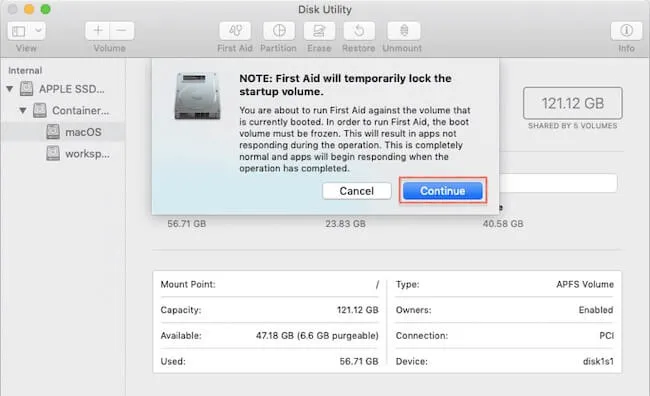
Fix 2. Fix unmounted Macintosh HD with Terminal
If Disk Utility failed to repair the disk, and the Macintosh HD not showing in Disk Utility issue remains, then you can try another macOS utility - Terminal to fix the hard drive not mounting issue. Here's how:
1. Boot Mac in Recovery Mode.
2. From the menu, click on Utilities > Terminal from the list.
3. Enter diskutil list and check the Volume Identifier.
4. The mentioned command will list available volumes. Check the volume identifier in the table that appeared.
5. Enter diskutil repairvolume /disk **. [** needs to be replaced with Macintosh HD's volume identifier].
Fix 3. Run FSCK command in Single User Mode
FSCK is a command-line tool to check the consistency of a hard drive and repair disk errors. If the solutions above are unable to fix Macintosh HD or the Mac internal hard drive not mounting issue, you can have a try.
1. Restart your Mac and, before the Apple logo appears, hold down Command and S keys to boot into Mac Single User Mode.
2. Type in:
/sbin/fsck -fy
3. If you see "File system was modified", then re-type in the command again until you see "The volume [name] appears to be OK".
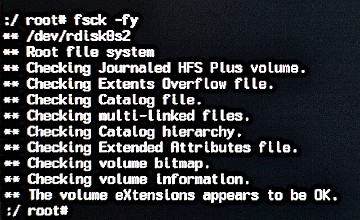
4. Type in the command to restart your Mac:
reboot
Fix 4. Try Safe Mode
When trying to boot into Safe Mode, macOS will scan and repair any errors it finds on the boot disk.
To boot into Safe Mode, you need to shut the Mac down and start it up while holding down Shift. Release the Shift key when you see the login window. Should your computer boot properly, try restarting and booting as normal.
Fix 5. Reset NVRAM on your Mac
NVRAM is a small amount of memory used to store certain settings for quick access on Mac. The corrupted NVRAM can cause Mac glitches or even prevent macOS from starting.
So, if your Mac computer won't boot properly, you can attempt to reset the NVRAM. Reboot your Mac and hold down the "Command + Option + P + R" keys. After resetting, you can try to mount Macintosh HD on Mac.
Fix 6. Erase Macintosh HD and reinstall macOS
If the Macintosh HD won't mount, and your Mac still cannot recognize the Mac's internal hard drive, the final chance is to factory reset the Mac-format Macintosh HD and reinstall macOS on it. But as you know, reformatting will erase all the data stored on the Macintosh HD. Please make sure you have recovered data with iBoysoft Data Recovery.
1. Boot your Mac to macOS Recovery Mode.
2. Select Disk Utility from the macOS Utilities menu.
3. Select the unmountable Macintosh HD from the sidebar.
4. Click Erase from the top.
5. Set up the required information (i.e. Name, Scheme, Format, etc.) to reformat the disk and click Done when finished.
6. Go back to the macOS Utilities screen and select Reinstall macOS.
Fix 7. Send your Mac for repair
After macOS reinstallation, your Macintosh HD still greyed out in Disk Utility or not found up on Mac. Or you have encountered the worst case: finding the Macintosh HD not showing in Disk Utility.
As there's no startup disk in Disk Utility when you boot into macOS Recovery mode, it means that your Mac cannot find the boot loader. Your Mac hard drive is either dead or not properly connected.
In this case, a professional hardware repair is necessary. You can send it to an Apple Repair Center.
What to keep in mind: Once you encountered the Macintosh HD not mounted error, the first thing you should do is to save your data on the Mac hard drive. Without regular backups, a data recovery program like iBoysoft Data Recovery for Mac will help you recover lost data from the unmounted Mac hard drive. Then, try to fix the hard drive not mounting issue.
Why does Macintosh HD not mounted/showing in Disk Utility?
Curious about why the internal hard drive is not mounting on Mac? Here are the possible reasons.
The volume Macintosh HD, which is not mounted (greyed out) or not showing up in Disk Utility, is found corrupt and needs to be repaired before mounting for those 5 primary reasons.
1. File system damage
The file system is responsible for how data is organized and stored in a drive. If the file system of the Macintosh HD is corrupted, the master file table will be impacted in a direct manner so the Mac won't mount Macintosh HD.
2. Catalog file corruption
Catalog files contain the record files of partitioned volumes. So if any catalog file becomes corrupt, the Mac won't be able to get volume size location, description of volume content and other volume information, let alone mount the drive.
3. Disk Utility failures
The Macintosh HD not mounted issue may be caused by Disk Utility faults, too.
4. System malfunctions
System malfunctions include machine malfunctions and operating system errors. If the Mac operating system crashes, it cannot mount any drive.
5. Virus attacks
Perhaps, your Mac system or the Macintosh HD is attacked by a virus or malware, resulting in data corruption. Then your Mac won't mount the Macintosh HD, either.
Final thoughts
Macintosh HD not mounted in Disk Utility, or even no Macintosh HD in Disk Utility, is a common issue in daily life. This post draws the most efficient ways to help you fix this problem.
By the way, data loss is inevitable if you encounter an internal hard drive not mounting on a Mac. So, retrieving data with iBoysoft Data Recovery for Mac in macOS Recovery mode is necessary.
If this tutorial helps you out of trouble, why don't you share the joy with your friends?
